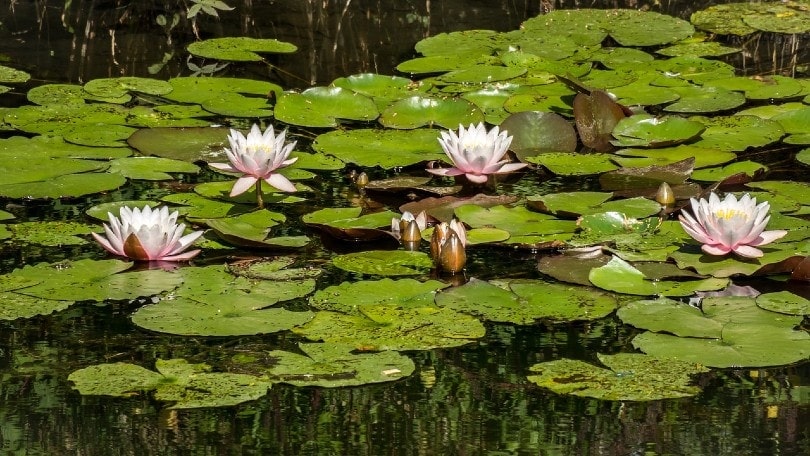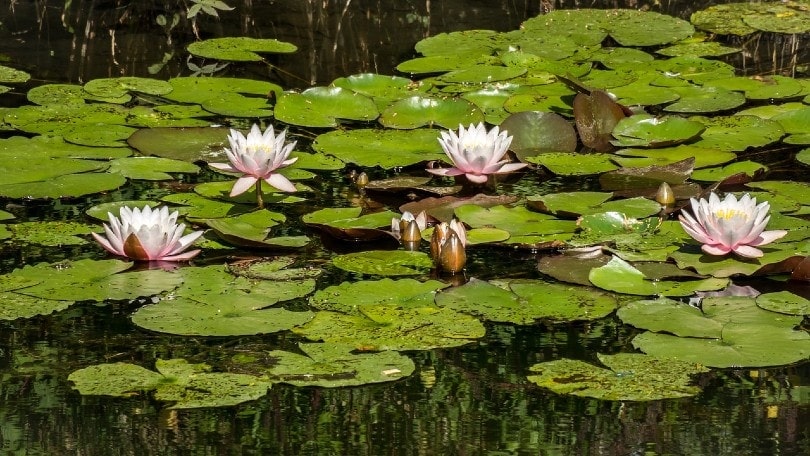
Ponds are notoriously hard to maintain, at least much harder than your normal aquarium. The reason for this is mostly because they are usually outdoors and exposed to whatever Mother Nature throws at the pond. How to clean pond water naturally is something that we are often asked about. Well, a good solution is to get yourself some good plants.
If you didn’t already know, plants are great at filtering water, they help feed fish, provide creatures with hiding spaces, and so much more. Plants don’t just look nice, they actually have many functions in a pond or aquarium.
Today we are here to find the best pond plants to keep water clear. As you will see, while it might be a little difficult to maintain a crystal clear pond, these plants will give you a leg up.

A Quick Comparison of Our Favorites (Updated in 2024)
| Rating | Image | Product | Details | |
|---|---|---|---|---|
| Best Overall | 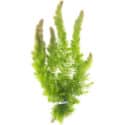 | Hornwort | Check Price | |
| Best Value |  | Water Lettuce | Check Price | |
| Premium Choice |  | Water Hyacinth | Check Price | |
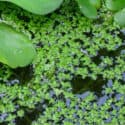 | Duckweed | Check Price | ||
 | Watercress | Check Price |
The 10 Best Pond Plants To Keep Water Clear
In all fairness, pretty much every single pond plant out there will help keep pond water clear, but they do have certain differences. Simply put, some pond plants are better for filtration and water clarity than others.
Here we have a nice little list of the 10 very best pond plants to keep water clear and clean.
1. Hornwort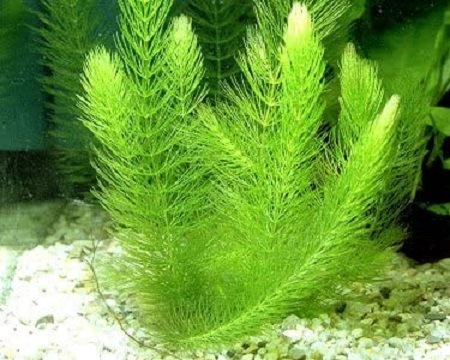
Hornwort is probably one of the best options to go with when it comes to pond water filtration. What is really good about this plant is that it grows very fast and has a high metabolic rate.
In other words, it sucks up a whole lot of waste out of the water in order to grow so fast. Yes, it will require regular pruning and maintenance due to its quick growth, but this is not a big problem as long as you do so about once per month.
It’s a good plant to have in a pond because it really doesn’t require any special treatment. As long as you have a good substrate to plant it in, a good amount of nutrients in the water, and a decent amount of sunlight, this stuff will grow really well.
It’s a good low maintenance plant for beginners to have in a pond. It looks really nice, it makes for a good foreground or mid-ground plant, and it is super efficient and removing impurities from water.
2. Water Lettuce

Water Lettuce is another great option to go with for many different reasons. First and foremost, this is a fairly large and quick growing plant, which once again means that it absorbs quite a bit of waste and substances from the water.
It has a very efficient growth rate which makes it ideal for water clarification and purification. This thing is like an interesting mix between a large flower, a Lilly pad, and a head of lettuce. It is indeed a floating plant.
It is a fairly big floating plant, one that is good for creating some shade and cover for your fish. Just be sure to maintain it fairly often so that it does not overtake the surface of the pond, or else it will create too much shade. Being a floating plant is nice because it means that you don’t have to worry about the substrate.
Just make sure that there are enough nutrients in the water to sustain the water lettuce. They are easy to maintain, but they really like sunlight and will grow well with lots of it.
3. Water Hyancinth
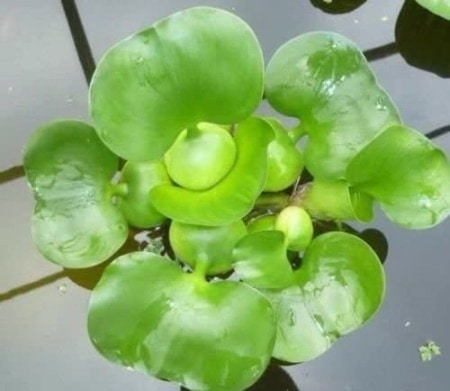
You probably know what a Hyancinth is. Well, the Water Hyancinth is a floating version of that plant. It is like a mix between a Hyancinth and a Lilly pad. It certainly does look very nice, especially when the colorful flower blooms.
Fish like this plant because it helps provide a bit of cover from predators above, plus it helps provide some shade too. The Water Hyancinth grows fairly fast, making it quite efficient at water filtration.
It is indeed one of the better pond plants for keeping water clean and clear as it has a very efficient filtration system. This plant does like to be warm, it likes sunlight, and it likes to get a lot of nutrients.
It is not over hard to maintain, but you do have to provide it with the right conditions, plus you will need to trim it every now and then to help stop it from overtaking the pond. It’s not the easiest plant to maintain, but certainly not the hardest either.
4. Duckweed
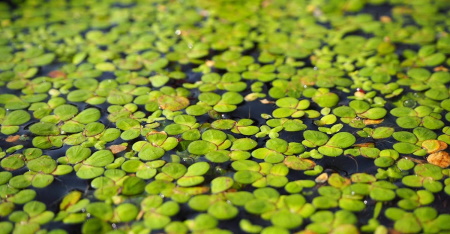
Duckweed is also great at filtering water. Duckweed is a small but fast growing plant that can really branch out. It looks like a bunch of stems with a whole lot of small, green, and rounded leaves. It is almost like a cluster of miniature Lilly pads.
It’s a cool looking plant that can act as cover for fish, it can provide minimal shade, and some fish even like eating it too. It is a good option because it is low maintenance.
It is a floating plant, so it does not require substrate. As long as there are lots of nutrients in the water column, duckweed will grow just fine. It likes the water to be fairly clean and it does like getting a lot of sunlight.
However, overall maintenance is minimal. It is a fast growing plant that spreads quickly, so you will need to trim it often. However, this fast growth is also beneficial for your pond because it means that duckweed filters water fairly fast and very well.
5. Watercress
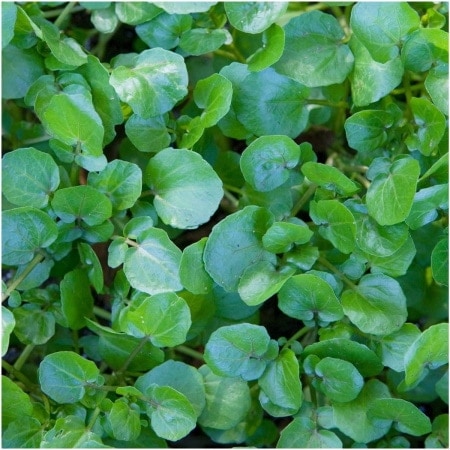
You might be familiar with watercress as it is a plant that we humans eat on occasion. It is quite popular to add into dishes in South America. Some fish do like to eat it, which is a big bonus if you want to save money on fish food.
These are best for large ponds because they can grow up to 24 inches in height and they grow really fast. Water Cress will need to be trimmed and maintained in order to stop it from taking over a pond due to its extremely fast growth and large size.
However, other than that, watercress doesn’t require much work at all. It is a floating plant, so substrate is irrelevant as long as there are lots of nutrients in the water. it does really well with lots of sun, but will also grow in lower light conditions.
Once again, the quick growth of it does help to filter water. This plant is a very efficient water filtration plant, one that eats up a whole lot of water contaminants that can make pond water cloudy.
6. Pickeral Plant

In terms of a hardy plant for ponds that is easy to care for, the Pickeral Plant is one of the best out there. It requires a fair amount of sunlight and nutrients, but that should not be an issue in a pond that is outdoors.
It is a rooted plant, so you will need to have some good substrate with lots of nutrients in it, but having lots of nutrients in the water column won’t hurt it either. The Pickeral Plant is known for being hardy and resilient, which is always a big bonus.
In terms of water filtration, the Pickeral Plant does a pretty good job. It grows at a decent rate, so it does a fairly good job at absorbing excess nutrients and substances from the pond water. It is not quite as good as some of the other options we have looked at, but it still gets the job done.
This is a beautiful plant with a thick stem and many small flowers on the top. It definitely looks nice. It grows tall and may even penetrate the surface of the water, but it doesn’t grow wide, so trimming needs are minimal.
7. Water Lilies

In terms of beauty, you will be hard pressed to find a more beautiful and captivating plant for your pond. Water lilies can come in many different colors and they are all breathtaking.
These things bloom for many months, making them ideal for warm weather climates. Fish do like water lilies because they provide a lot of shade from the sun and predators from above, both good things of course.
Water lilies are floating plants, so you don’t need to worry about the substrate, but you do need to add nutrients into the water on occasion (if necessary). They do like to get a whole lot of sunlight, so putting them in a well-lit area is essential.
Other than that, they tend to be quite hardy, so other than some population control, you won’t have to do much maintenance. The water lily is a really good plant for pond water filtration, especially if you have a few of them.
8. Variegated Water Celery
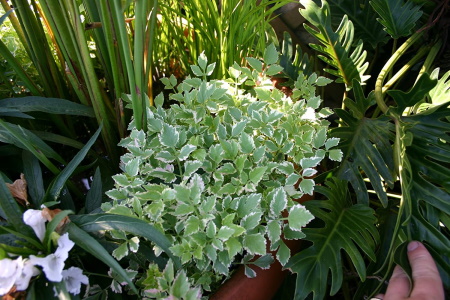
Yet another cool plant to go with, variegated water celery is definitely great for filtering pond water. It kind of looks like a big fern with large rounded leaves. It is not the most beautiful of all pond plants, but at least it is green.
This is actually a shallow plant. It likes to have its roots in the soil below the water, but most of the plant grows above the water. So, be sure to have a good substrate with lots of nutrients and place it somewhere where it can easily penetrate the surface of the water.
This stuff does grow really fast and really tall, so you might need to trim it on occasion depending on how big your pond is. Other than that, as long as you have it in a sunny place, it should grow just fine.
Water celery is pretty hardy, so killing it is not easily done. This stuff is great for sucking excess nutrients and contaminants out of the water, especially out of the substrate, making it a really good pond filtration plant.
9. Water Thyme
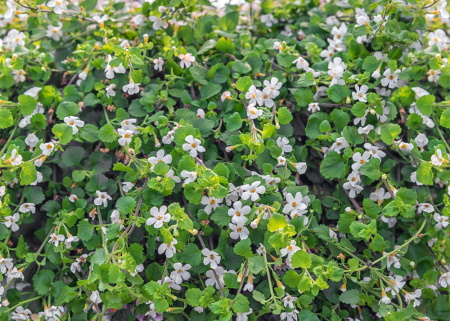
Normal thyme is a herb that grows on dry land, a herb that we humans use all the time to cook. Well, there is also such thing as water thyme, the cousin of land thyme. This stuff grows underwater, is usually submerged, but can also grow in shallow water, sometimes coming to the surface.
It more or less looks like normal thyme, except it is much smoother and has much less leaves. To be quite honest, it is not the most beautiful pond plant out there.
However, that being said, water thyme is totally excellent for filtering water. It grows fairly fast and it needs a lot of nutrients to do so. It is an efficient pond filtering plant that eats up a whole lot of problem causing substances.
What is funny is that this plant is usually considered to be an unwelcome and invasive plant species, but people seem to have found many uses for it, especially in home outdoor fish ponds.
10. Floating Fern
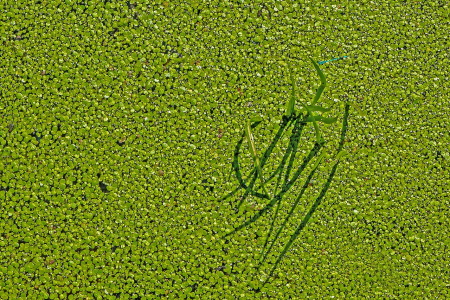
This final plant on our list is yet another good one to consider. This is a green plant that forms leaf clusters at the water’s surface. The floating fern kind of looks like a hybrid between a lily pad and a fern. This is a floating plant, so once again, substrate is irrelevant as long as the water itself has lots of nutrients to sustain it.
It likes getting a lot of sun, but other than that, maintenance is straightforward. It does grow pretty fast, so occasional trimmings are needed to stop it from overtaking a pond.
We do like how the floating fern is fairly easy to maintain. Also, fish like it because it can act as a food source, it attracts insects, it provides cover and hiding spots, and it provides shade from the harsh sun too. In terms of filtration, it holds its own no doubt. It grows pretty fast and definitely removes a good amount of contaminants from water.
How Can Plants Help Keep My Water Clear?
People also often ask us “what kinds of plants filter water?” Well, the answer to that is that they all do. Now, they don’t all do it to the same extent or in the same capacity, but virtually every plant out there filters water.
It may not be all that obvious at first, but there are actually many different ways in which a good plant can help keep your pond water clean and clear. Plants are a lot more than blobs floating around in the water and they do a lot more than just look nice.
Plants act as filtration units in various capacities. Let’s talk about the main ways in which plants help keep water clean and crystal clear.
Oxygenation
For one, plants create oxygen through the process of photosynthesis. This oxygen is then released into the water. For one, this is good because it helps fish breathe better.
Also, oxygen floats to the top of the water and dissipates into the air above it. This helps to lift and release various substances from the water which could be causing cloudiness and discoloration.
Reduction Of Algae
One of the main ways which plants help keep water clean and clear is by reducing the chances that there is an algae bloom. Algae doesn’t look nice, it gets all throughout the water, it consumes nutrients, sunlight, valuable space, oxygen, and more.
You just don’t want it in your tank. The more sunlight and nutrients is being created by your pond plants, the less of these things there are for algae to feed on.
Reduction Of Substances (FILTRATION)
All in all, plants act as really good filters for varous substances. Ammonia, nitrites, and nitrates are all poisonous things that can and do hurt fish, so they shouldn’t be in ponds at all.
These things can also cause water discoloration and bad smells too. Moreover, algae likes to feed on ammonia. Well, pond plants consume and absorb those substances, this helping to stop smells, discoloration, algae blooms, and the death of your fish. Water filtering plants for ponds are a big deal no doubt.
Types Of Pond Plants
There are 3 main types of pond plants that you can get, all of which are represented in the 10 above plants that we have reviewed. Let’s quickly go over each of the 3 main varieties to see what you are getting yourself into.
Floating
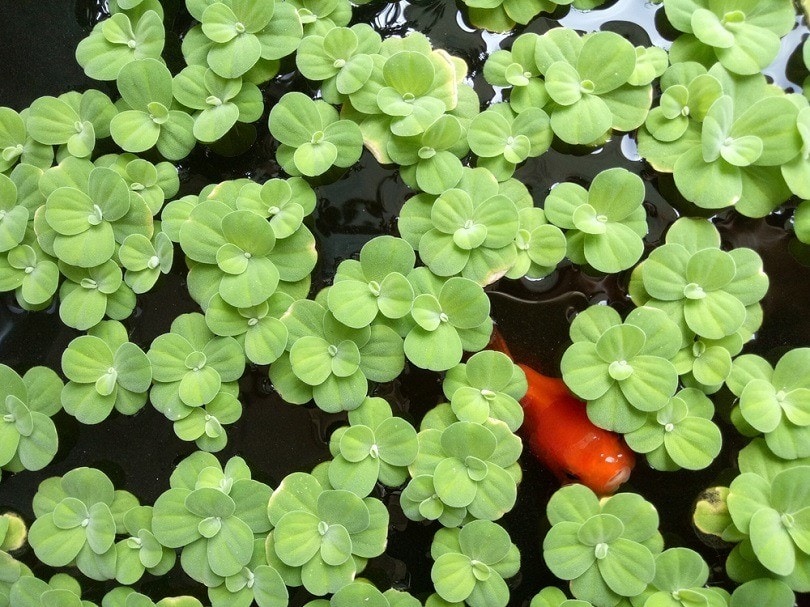
Floating plants tend to be very common in ponds. They do an amazing job in terms of water filtration, especially the large and fast growing ones. Now, they might not do as good a job as submerged plants because much of the floating plant is above water, but it can definitely hold its own.
These plants need a lot of nutrients in the water column and they need lots of sunlight. Since they float, substrate is completely irrelevant. Pond fish tend to like floating plants because they attract insects, they can be food themselves, they provide cover from predators, and they help to provide shade from the sun too.
Shallow
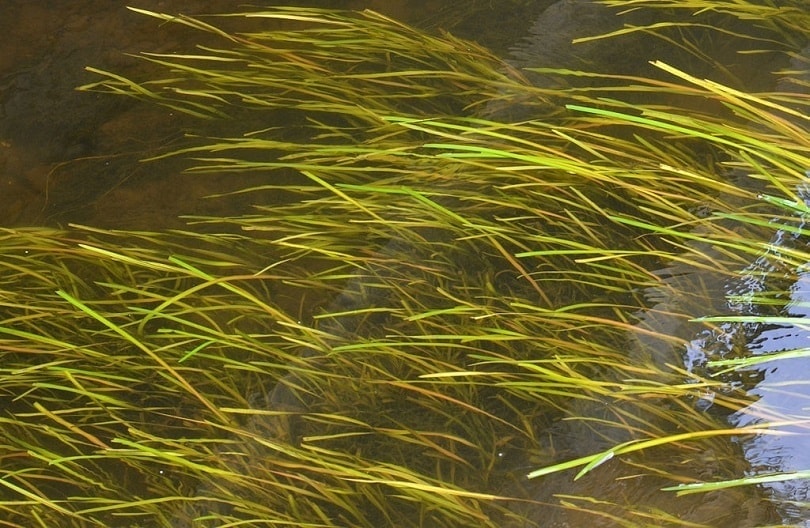
Shallow pond plants are like the halfway stage between floating plants and submerged plants. Shallow pond plants are rooted in the substrate, so they need a good, thick, and nutrient rich substrate to survive. They often have long stems with leaves or flowers that poke out well past the water’s surface. They like to have lots of sunlight in general, so putting them in a well-lit area is a must.
Fish like these plants because they tend to attract a lot of wildlife that can be eaten as food. At the same time, shallow water plants tend to be good for cover from the sun as well as from predators. These do a mediocre job at water filtration due to the fact that most of the plant is above water, but the roots still take in a heck of a lot of unwanted substances.
Submerged

Submerged pond plants are the absolute best when it comes to water filtration. Since both the roots and the plant itself is submerged, it is fully engaged in water filtration. These plants feed both off of the substrate and the water column, so a good mix of water borne nutrients and a good substrate is essential.
These plants usually don’t need quite as much sun as the other 2 types, but they need enough nonetheless. Fish tend to like these plants for playing, for hiding, cover, and for shade too. Many submerged plants also act as food sources for fish.
You might also like our Pond Dye Buying Guide, which you can find here.
FAQs
Do ponds need oxygenating plants?
Yes, your pond does need oxygenating plants to be healthy. For one, if you have a very large pond and you don’t want to get multiple large and expensive air pumps, some good oxygenating pond plants can help provide your fish with the oxygen required to be healthy and to breathe.
Moreover, there are many natural pond filter plants, and yes, oxygenating plants often act as a filter for ponds and eat up nutrients that would otherwise be left for algae to feed on.
In terms of good pond cleaning plants, we would suggest:
- Anacharis
- Red Ludwigia
- Hornwort
- Mermaid Plant
- Cabomba
- Vallisneria
- Moneywort
- Lemon Bacopa
- Rotala
Do floating plants oxygenate the water?
When it comes to aquatic plants that filter water, unfortunately floating plants are not at the top of the list, at least not in terms of oxygenation.
Alright, so floating pond plants are indeed awesome for a variety of reasons, and this includes providing your fish with some privacy, blocking out some sunlight, and providing cover from predators.
However, most of the oxygen which floating plants produce is released upwards into the air, not down into the water.
Are Water Lilies good for ponds?
In terms of plants that clean water, water lilies are pretty decent, although they won’t really oxygenate the water much.
That said, the large leaves of water lilies are great for providing shade and cover for your fish. Moreover, water lilies do eat up a lot of nutrients which would otherwise be left for algae to feed on, plus they do well at blocking out sunlight required by algae too.
There is also the fact that water lilies are not too difficult to care for, plus they look really beautiful too.

What are the best oxygenating plants for a small pond?
Of course, there are some plants which are better for oxygenating ponds than others. Moreover, if you have a small pond, you do want plants that are as efficient at oxygenation as possible, all without taking up a ridiculous amount of space.
Some good examples that do well with oxygenation, include the following:
- Arrowhead
- Eel grass
- Fanwort
- Hornwort
- Red Rotala
- Water Weed
- Water Sprite
- Water Wisteria
How do I keep my pond plants alive?
As is the case with all plants, there are specific parameters that need to be met in order to keep pond plants alive.
For one, the pond water needs to be of the right temperature, not too hot or too cold. Next, the pH or acidity level of the water is going to decide this as well.
Adding some fertilizer and CO2 to the water is something else you might want to consider for really healthy plants.
Moreover, a good filtration unit to filter out debris is a big deal. Also, it probably does not hurt if you choose pond plants that won’t get eaten by fish.
Do pond plants die in winter?
Besides very hardy pond plants that are fully submerged, yes, most pond plants will freeze and they will not survive the winter.
If you want them to survive the winter, you will need to remove them from the pond and bring them inside until the spring time.
How do you prune a pond plant?
There is no straightforward answer to this as different plants need to be pruned differently.
We cannot make a generalization here as some plants need to be pruned this way and some that way.
If you want or need to prune your pond plants, you need to research the specific plant in question.

Conclusion
There are tons of pond plants to keep water clear, you just have to know which ones are the right ones. The 10 options which have been discussed above are generally regarded as being the very best pond plants to keep water clear (Hornwort is our top pick), plus they are beautiful and serve many other awesome functions too.
See also:
Feature Image Credit: Thomas B., Pixabay
